General Information
Although Bali is warm all year round, there are its own pros and cons of traveling at different times of the year. Depending on how you like to spend your time and what you are interested in, it makes sense to plan your trip according to the seasonality of the island. Proximity to the equator means that there are only two seasons here — rainy and dry. In both seasons there is something to do and to see. Because of the proximity to the equator, Bali has high humidity and high temperatures throughout the year. The temperature is relatively constant throughout the year with only a difference of 4–5°. The southeast monsoon brings Bali a hot dry season, while the northwest monsoon brings heavy showers in the rainy season. Natural phenomena El Niño and La Niña also affect the island’s climate.
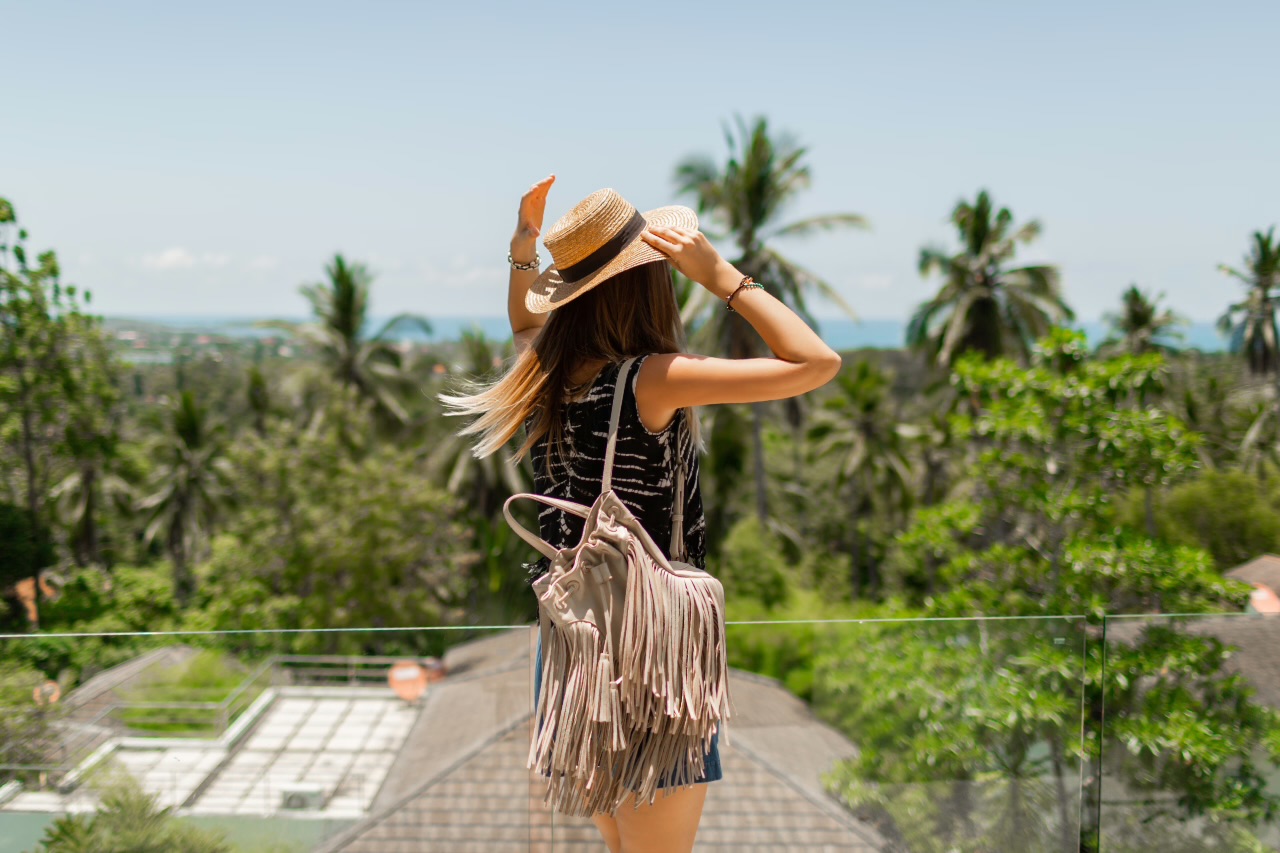
If you are planning an annual family vacation, a wedding or a honeymoon in Bali, it is extremely important to plan everything accordingly. The optimal time for yourself to visit Bali can be determined based on the table:

So, what is important for you?
- Surfing: from April to September
- Clear weather: from April to October
- Beach holiday: from April to October
- Minimum tourists: from November to April (except Christmas and New Year holidays)
- Budget-friendly: from February to early June and from October to early December
- Diving: from September to November
- Outdoor events, hiking: from May to September
The best time for a wedding or a honeymoon in Bali is the dry season (May–October). This period is also the most expensive time to visit Bali, but it is worth it. After all, you can be sure that the wedding ceremony will not be spoiled by a sudden downpour.
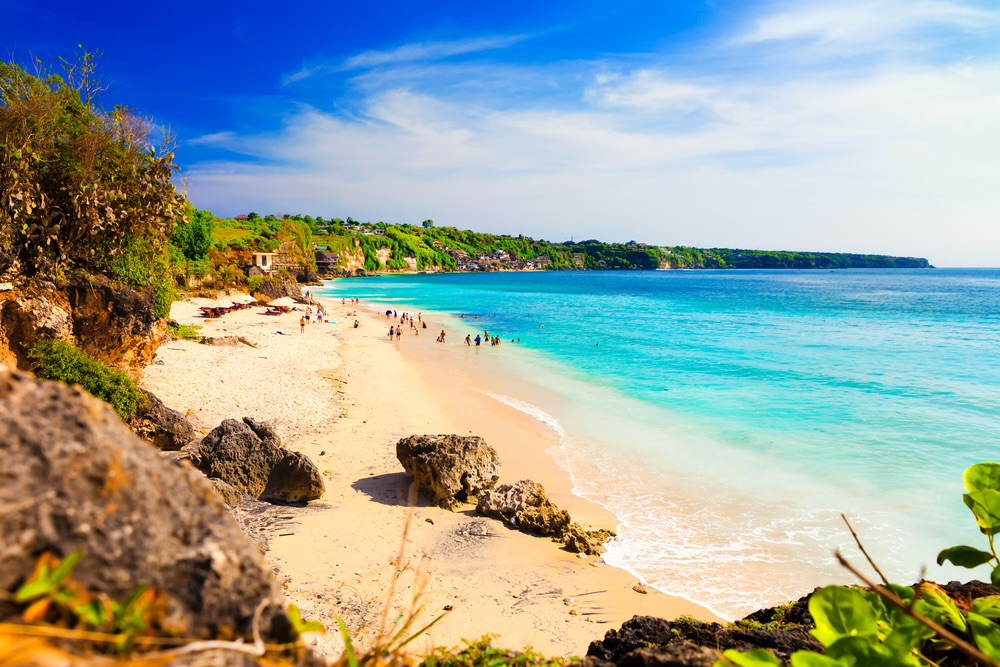
The dry season in Bali lasts from May to September. During this period, the daytime temperature is the highest, averaging from 27° to 28°C, but nights become cooler. In the morning and evening you want to put on a light jacket. Humidity is the lowest — 60%. The number of rainy days is also the lowest: from 8–9 in May to only 3–4 days in August.
The rainy season in Bali begins in October and lasts until April. The temperature drops slightly, averaging 26–27°C, but this is hardly noticeable due to the high humidity. The number of rainy days increases to an average of 8–16 days per month. Air humidity during this period also increases from 65% to 85%.
During the rainy season the island is usually visited by Europeans and tourists from CIS countries. The rainy season is the low season in Bali except for Christmas and New Year (this is the peak season) and Chinese New Year (this is the high season).
It is worth noting that the amount of rainfall in Bali is not the same throughout the island. The most rainfall is in the mountains (3,000 mm per year), and the least — on the northern coast (only 1,000 mm per year).
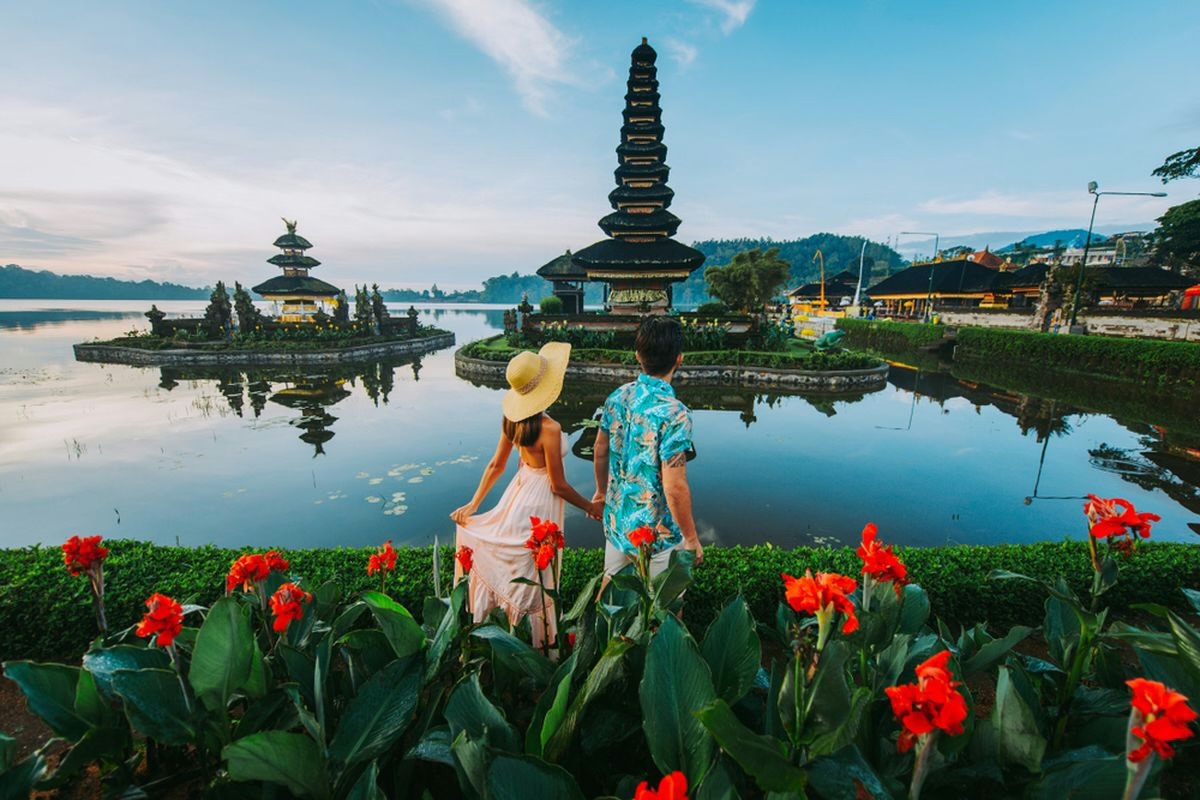
In June–August is the dry season. It can also shift and be uneven. At this time the sky is clear, almost without clouds, but in August there can be strong winds and it is quite cool in the evenings. Even in the dry season in the highlands of Bali it may rain.
During the dry season in Bali the number of Australians and Brazilians increases. Tourists in general become more numerous. The period of June–August is the high season in Bali.
Most tourists prefer to travel to Bali in the dry season, that is from May to the end of September. Due to the small number of rainy days, low humidity and high water temperature in the ocean — this is the perfect time for sightseeing. Hiking, mountain trekking, climbing Mount Agung, as well as water sports and beach holidays — all this are great opportunities for guests of the island.
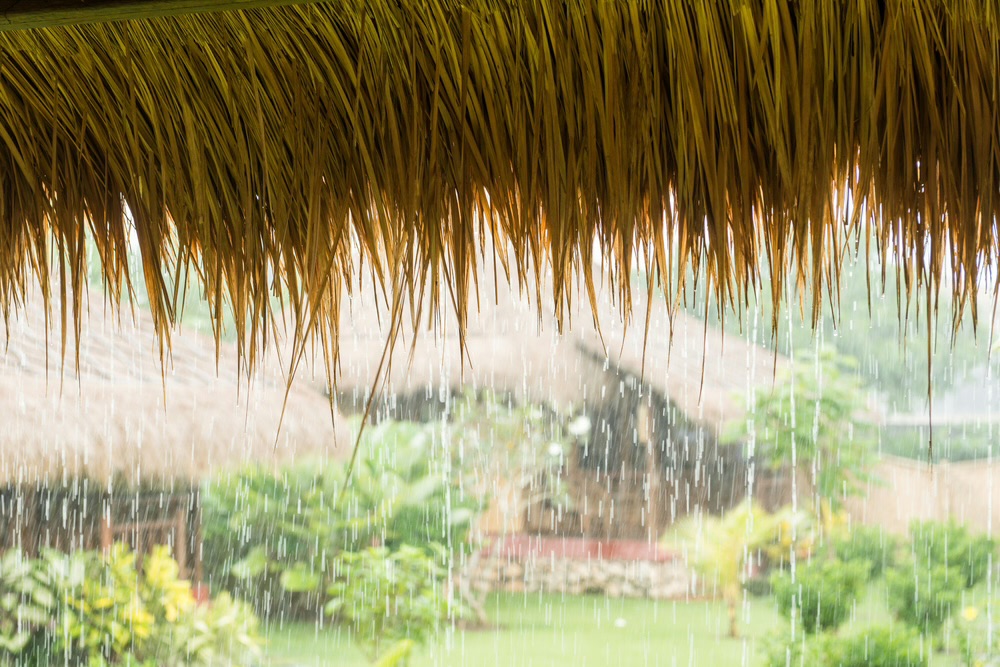
Does this mean that you should not go to Bali in the rainy season? Absolutely not! Despite the monsoon season, staying in Bali can be no less interesting. The months of October–November and April are very warm, sunny and not as rainy as other times of the year. You can do water sports and swim here all year round thanks to the high water temperature both in the dry and rainy seasons. You can plan a holiday to enjoy the sun and sea swimming also in the rainy season. Go to the northern coast, where you may get caught in a short tropical shower, which cannot spoil your day. At this time it is better to refrain from trips to the southern coast, as this part of the island will be flooded with heavy and intense rains.
Weather by Months
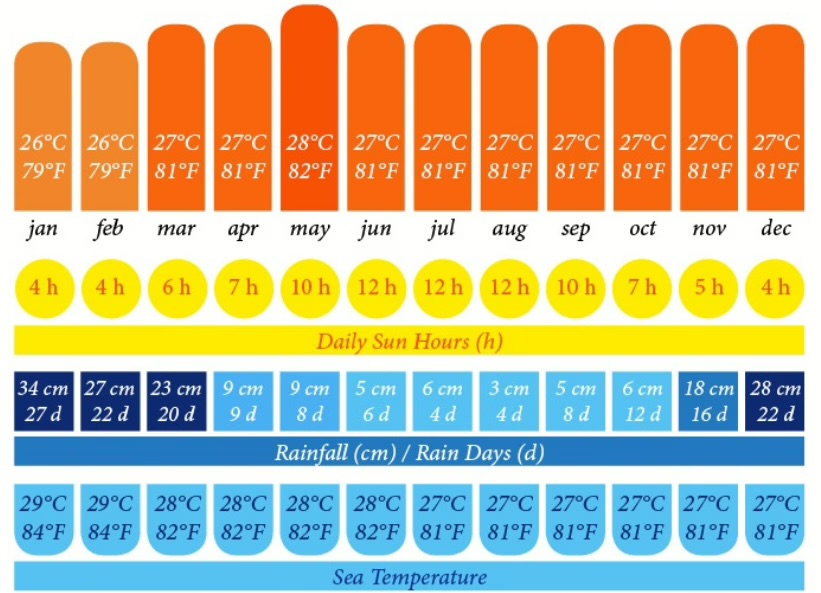
Weather in Bali in January
January is the rainiest month of the year in Bali. It is not uncommon for the rain to last several days in a row, especially in early January. There is also a high chance of stormy winds. The average temperature is also quite high, but due to frequent cloudiness and rains the heat is not strongly felt. The ocean is very warm, just like the rain.
On the western side of the island (Kuta, Jimbaran, Seminyak) the ocean can be dirty and rough.
Surfing is mainly at surf spots on the eastern side.
- Min temperature: 23°C
- Max temperature: 31°C
- Rainfall: 350 mm
- Rainy days: 27
Weather in Bali in February
In February the amount of rain decreases, and the temperature remains about the same, quite high. In general, the weather in Bali in February is unstable. Beaches in the west may still be dirty.
Although this month is a little drier than January, tourists still face frequent rains. High temperatures and damp weather mean that humidity is especially high this month, making the weather seem even hotter.
- Min temperature: 23°C
- Max temperature: 31°C
- Rainfall: 280 mm
- Rainy days: 22
Weather in Bali in March
Rains in March are already quite rare and not prolonged, most often at night. It becomes even hotter, during the day air conditioning is necessary. The water in the ocean is very warm.
March is one of the hottest months in Bali. Be careful when walking at noon — you can get heatstroke. If you do walk during the day, it is advisable to wear a hat, stay in the shade, and drink as much cool (but not cold) water as possible. If you are at the beach, take frequent dips in the ocean.
In general, it is worth knowing that in the center of the island (for example, in Ubud) the weather is always much rainier than in the south of Bali.
In March usually falls the “Day of Silence” (Nyepi, Balinese New Year).
March marks the end of the rainy season in Bali, when rainfall becomes weaker and rarer. The sky is often cloudy, but there are already more sunny days.
- Min temperature: 23°C
- Max temperature: 31°C
- Rainfall: 215 mm
- Rainy days: 20
Weather in Bali in April
The amount of rain decreases rapidly, strong winds also become less. It is still very hot. April is the first month of the dry season, and from this moment the weather becomes much sunnier and more stable. Air humidity in April also drops sharply, making the air feel cooler. Despite the good weather conditions, April is a calm month for tourists in Bali, so this is the perfect time to go if you want to avoid the peak activity on the island.
- Min temperature: 23°C
- Max temperature: 31°C
- Rainfall: 90 mm
- Rainy days: 9
Weather in Bali in May
May is quite a dry month in Bali, but still hot. Rains occur a couple of times a week. May is a month of seasonal change. Winds change their direction.
By the end of the month the ocean water gradually begins to cool. This is one of the most pleasant months to visit the island. Usually in May there are many sunny days in Bali, occasionally cloudy and with light rain.
- Min temperature: 23°C
- Max temperature: 31°C
- Rainfall: 75 mm
- Rainy days: 8
Weather in Bali in June
Also very dry, even fewer rains. It is already starting to get cooler, evenings are very pleasant. The water is of medium temperature. The lowest humidity in Bali is from June to October, so during this time the air on the island is the coolest and freshest. June marks the beginning of the tourist season in Bali, and by the end of the month the number of people on the island noticeably increases.
- Min temperature: 22°C
- Max temperature: 30°C
- Rainfall: 70 mm
- Rainy days: 6
Weather in Bali in July
In July on the island of gods it is very comfortable. During the day it is not hot at all, and in the evenings even cool. For a walk or bike ride you will want to put on a windbreaker. There may be no rain all month (except in central parts of the island).
The ocean water is rather cool. You cannot splash in the ocean all day long, only short swims. A good time for surfing. Low humidity and no rain — in July Bali has perfect weather. Thousands of tourists from all over the world begin to arrive. If you come at this time, be sure to take sunscreen with you, as solar radiation in July is the most intense.
- Min temperature: 22°C
- Max temperature: 29°C
- Rainfall: 50 mm
- Rainy days: 4
Weather in Bali in August
August is very similar to July. Dry, not a single rain all month, comfortable temperature, good surfing. On August 17 Indonesia celebrates Independence Day. Indonesians are very patriotic, flags are displayed at every house. A good time to visit the island. August is the best time of the year for a beach holiday. No wonder that in popular tourist places it becomes very crowded.
- Min temperature: 22°C
- Max temperature: 29°C
- Rainfall: 15 mm
- Rainy days: 4
Weather in Bali in September
In September in Bali there may already be rare rains. Daytime temperature gradually rises. But overall everything is very comfortable. Because of the start of the new school year many tourists leave the island, but for many others this is the best time of year to visit. The atmosphere is more relaxed, and the weather is still magnificent — ideal for shopping, swimming, and sunbathing.
- Min temperature: 22°C
- Max temperature: 30°C
- Rainfall: 40 mm
- Rainy days: 5
Weather in Bali in October
Already quite hot, cloudy days are more frequent. The ocean is already warm enough. Still a good time to visit Bali. The rainy season begins to return, rains become more frequent, and humidity starts to rise. However, the weather this month is still mostly dry and pleasant. For surfers this is the best time of year to rest on the island, with world-class waves along the entire west coast of Bali.
- Min temperature: 23°C
- Max temperature: 31°C
- Rainfall: 90 mm
- Rainy days: 12
Weather in Bali in November
November is the beginning of the rainy season, but most likely, rains will happen at night, occasionally during the day and not prolonged. Warm ocean water, pleasant for swimming.
November is a changeable month in terms of weather. However, this should not discourage you from visiting, as in November there is also a lot of sun, and serious downpours usually only come in December.
- Min temperature: 23°C
- Max temperature: 31°C
- Rainfall: 150 mm
- Rainy days: 16
Weather in Bali in December
The rainy season truly begins in December, when showers and thunderstorms become more frequent and heavy. The air temperature is quite high, but due to frequent clouds and rains the heat is not strongly felt. The rain and the ocean are very warm. Sometimes strong stormy winds and waves are possible. Towards New Year rains become more frequent.
Hotel prices rise significantly closer to the holiday period.
- Min temperature: 23°C
- Max temperature: 31°C
- Rainfall: 290 mm
- Rainy days: 22
Climate by Regions
Central Bali (Ubud, Bedugul, Tabanan)
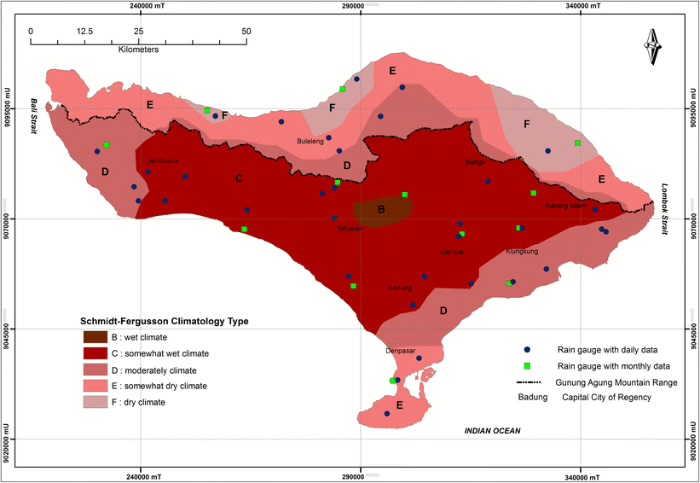
Central Bali is cooler and wetter compared to the coastal areas because of its higher elevation. Rainfall is heavier here, especially in January, and in the mountains temperatures can drop to 10°C, creating an unusual freshness for the tropics.
The main cultural hub is Ubud, famous for its temples, art galleries, dance performances, and excellent cuisine. It is the spiritual and artistic heart of the island. The best time to visit Central Bali is April to October, when rains are lighter and the weather is more stable.
South Bali (Denpasar, Kuta, Legian, Sanur, Canggu, Seminyak)
South Bali is the most popular region for tourists. Here you’ll find Bali’s capital Denpasar, world-famous beaches, resorts, lively nightlife, bars, and restaurants. The average annual temperature is around 28°C. The coolest month is August (about 25°C), while the warmest months are April and May (28°C).
Rainfall is unevenly distributed: in August there are only 2 rainy days, while from December to March there can be up to 19 rainy days per month. Despite the wet season, South Bali remains the vibrant tourism hub of the island year-round.
West Bali (Negara, Gilimanuk, Medewi, Pemuteran, Bali Barat National Park)
West Bali is the least visited region of the island, making it perfect for travelers seeking peace and nature. Most of the area is taken up by Bali Barat National Park, home to wild jungles, rare bird species, and unique ecosystems. The beaches remain untouched and are ideal for snorkeling and diving.
The climate follows the island pattern: the dry season runs from April to October, while November to March brings rainfall. With few tourists, West Bali is ideal for those who prefer seclusion and a more authentic natural experience.
North Bali (Lovina, Munduk, Singaraja)
The northern part of the island feels very different from the south. It is quieter and calmer, making it perfect for families. Lovina is famous for its black sand beaches and dolphin-watching tours.
The colonial town of Singaraja stands out with its historic charm and also serves as an academic hub with universities. The hottest months are November and December (around 28°C), while the wettest period is December to March, when rainfall is heaviest.
East Bali (Amed, Besakih, Candidasa, Kintamani, Klungkung, Mount Agung, Padang Bai)
East Bali is dramatic and rugged, dominated by the active volcano Mount Agung. The region features lush forests, black sand beaches, and sacred temples, including the famous Besakih Temple. Towns like Candidasa and Padang Bai (the ferry port to Lombok) are gateways for both culture and travel.
The wettest period is December to March, while the hottest months are November and December. East Bali is especially loved by divers and snorkelers thanks to its rich underwater landscapes and shipwreck sites.
Safety Rules
- Sunscreen: The sun in Bali can be very strong, and people with fair skin are especially at risk of burns. Sunscreen can cost more in Bali, so bring a good lotion with high SPF from home. Even on cloudy days UV is strong, don’t underestimate it.
- Hydration: It’s easy to get dehydrated, especially in the rainy season when humidity is highest. Always carry water and drink throughout the day.
- Mosquitoes: Present year-round, especially in rainy season. Dengue fever risk is higher then. Use repellents and wear long clothes at sunrise and sunset when mosquitoes are most active.
- Extreme weather: Bali’s equatorial location protects it from tornadoes, typhoons, and cyclones. These usually pass by, causing stronger winds and rains, but no significant danger.


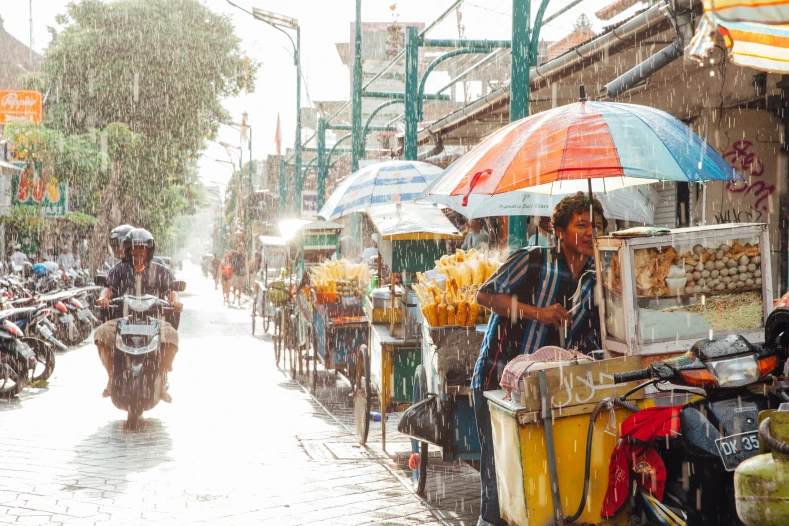
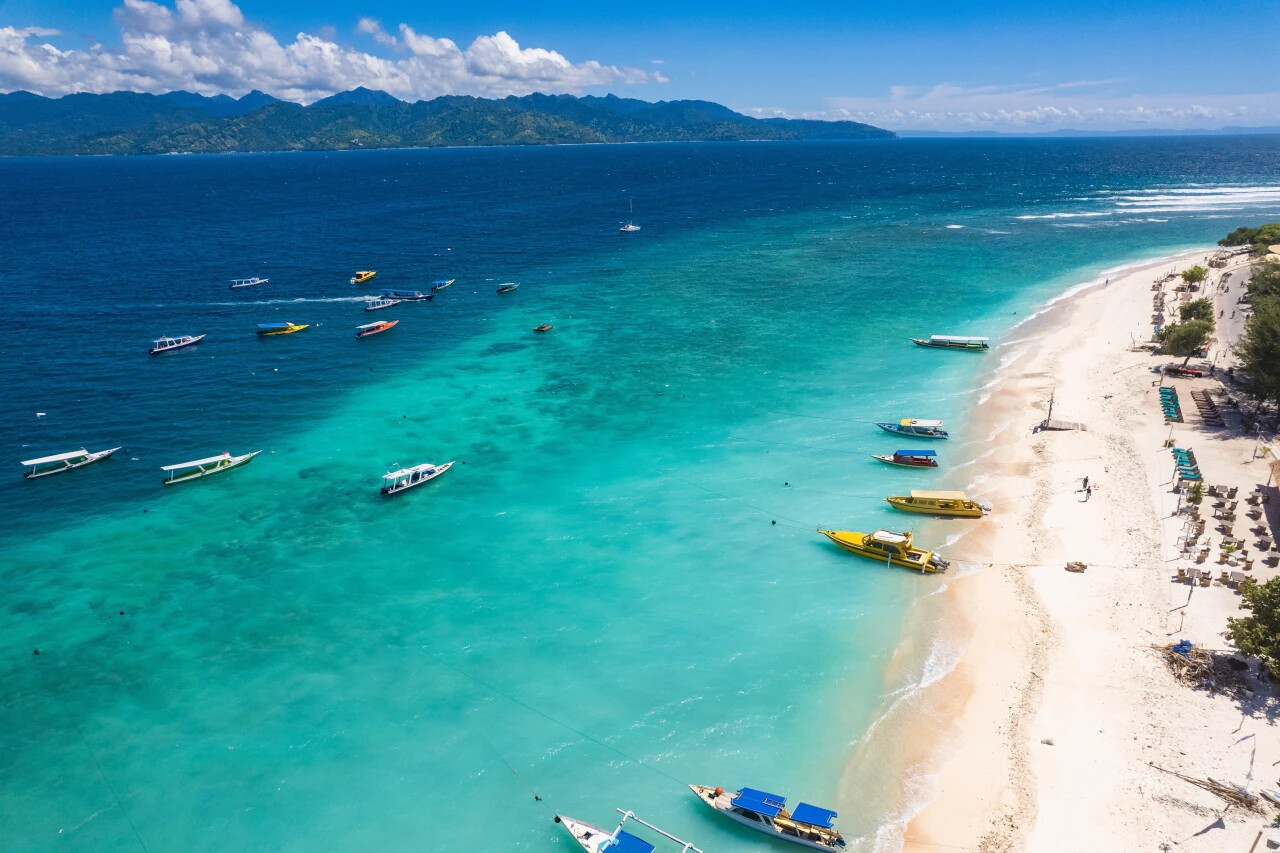
You can add one right now!